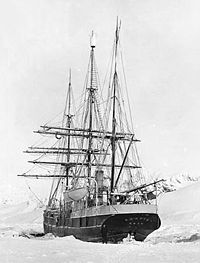Portal:Scotland/Selected articles/45

The Scottish National Antarctic Expedition (SNAE), 1902–1904, was organised and led by William Speirs Bruce, a natural scientist and former medical student from the University of Edinburgh. Although overshadowed in terms of prestige by Robert Falcon Scott's concurrent Discovery Expedition, the SNAE completed a full programme of exploration and scientific work. Its achievements included the establishment of a staffed meteorological station, the first in Antarctic territory, and the discovery of new land to the east of the Weddell Sea. Its large collection of biological and geological specimens, together with those from Bruce's earlier travels, led to the establishment of the Scottish Oceanographical Laboratory in 1906.
Bruce had spent most of the 1890s engaged on expeditions to the Antarctic and Arctic regions, and by 1899 was Britain's most experienced polar scientist. In March of that year, he applied to join the Discovery Expedition; however, his proposal to extend that expedition's field of work into the Weddell Sea quadrant, using a second ship, was dismissed as "mischievous rivalry" by Royal Geographical Society (RGS) president Sir Clements Markham. Bruce reacted by obtaining independent finance; his venture was supported and promoted by the Royal Scottish Geographical Society.
The expedition has been described as "by far the most cost-effective and carefully planned scientific expedition of the Heroic Age." Despite this, Bruce received no formal honour or recognition from the British Government, and the expedition's members were denied the prestigious Polar Medal despite vigorous lobbying. After the SNAE, Bruce led no more Antarctic expeditions, although he made regular Arctic trips. His focus on serious scientific exploration was out of fashion with his times, and his achievements, unlike those of the polar adventurers Scott, Shackleton and Amundsen, soon faded from public awareness. The SNAE's permanent memorial is the Orcadas weather station, which was set up in 1903 as "Omond House" on Laurie Island, South Orkneys, and has been in continuous operation ever since.
